
The League of Prizren, officially the League for the Defense of the Rights of the Albanian Nation, was an Albanian political organization that was officially founded on June 10, 1878 in the old town of Prizren in the Kosovo Vilayet of the Ottoman Empire. It was suppressed in April 1881.
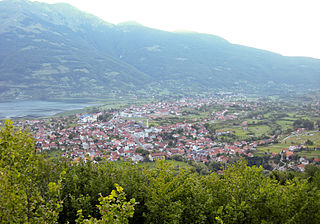
Plav is a town in Polimlje region in north-eastern Montenegro. It has a population of 3,717. Plav is the centre of Plav Municipality.
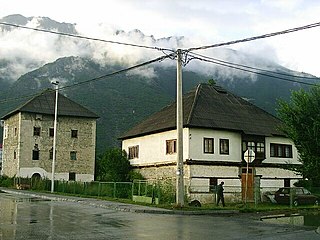
Gusinje is a small town in Polimlje region in north-eastern Montenegro. According to the 2011 census, the town has a population of 1,673 and is the administrative center of Gusinje Municipality.

Dedë Gjon Luli Dedvukaj also referred to as Ded Gjo Luli and Deda was an Albanian guerrilla leader most notable for commanding the 1911 revolt against Ottoman troops. He was posthumously awarded the "Hero of Albania" title. Dedvukaj was the clan chieftain of the Hoti tribe.
Albanians in Montenegro are an ethnic group in Montenegro of Albanian descent, which constitute 4.91% of Montenegro's total population. They are the largest non-Slavic ethnic group in Montenegro.

Kuči is a historical tribe (pleme) of Albanian origin and a region in central and eastern Montenegro, north-east of Podgorica, extending along the border with Albania. Processes of Slavicisation during the Ottoman era and onwards facilitated ethno-linguistic shifts within much of the community. As such, people from the Kuči today largely identify themselves as Montenegrins and Serbs, with a minority still identifying as Albanians. In other areas such as the Sandžak, many Muslim descendants of the Kuči today identify as Bosniaks.

Ali Pasha Shabanagaj, was an Albanian Muslim military commander and one of the leaders of the League of Prizren. He governed, as an Ottoman kaymakam (sub-governor), an area in what is today eastern Montenegro around Plav and Gusinje. He was commonly known as Ali Pasha of Gusinje. He was the leader of the Albanian irregular troops of the League of Prizren against the Principality of Montenegro at the Battle of Novšiće. He was governor of the area of Plav and Gusinje located in a valley between steep mountains.
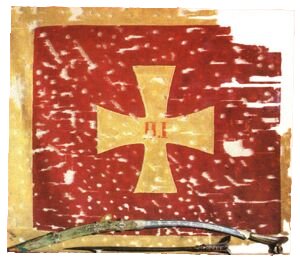
The Montenegrin–Ottoman War, also known in Montenegro as the Great War, was fought between the Principality of Montenegro and the Ottoman Empire between 1876 and 1878. The war ended with Montenegrin victory and Ottoman defeat in the larger Russo-Turkish War of 1877–1878. Six major and 27 smaller battles were fought, among which was the crucial Battle of Vučji Do.

Baca Kurti Gjokaj was an Albanian leader who participated in the Battle of Ržanicë against the Principality of Montenegro.
The Battle of Krusi was fought on 22 September 1796 between the campaigning army of Ottoman Empire commanded by Kara Mahmud Pasha, the Pasha of Scutari, and tribes of Prince-Bishopric of Montenegro under the command of Metropolitan Petar I Petrović Njegoš and Jovan Radonjić, at Krusi, Lješanska nahija.

The Attack against Mehmed Ali Pasha, known in Albanian historiography as the Action of Gjakova, was undertaken from 3–6 September 1878 by the Gjakova Committee of the League of Prizren in the estate of Abdullah Pasha Dreni near Gjakova. During the battle Mehmed Ali Pasha, the Ottoman marshal who was to overview the cession of the predominantly Albanian Plav and Gusinje region to the Principality of Montenegro, Abdullah Pasha Dreni, a notable official of the region and former member of the league, many Ottoman soldiers, and volunteers of the Gjakova Committee were killed.
Brda refers to a historical and ethnographical region in Montenegro. The Brda are one of the country's four historic tribal regions, along with Old Montenegro, Old Herzegovina and the Montenegrin Littoral. The historical tribes of the Brda are the Vasojevići, the Bjelopavlići, the Piperi, the Kuči, the Bratonožići, the Moračani and the Rovčani. Collectively known as "the seven tribes" or "the seven hills", they were referred to as "Highlander tribes" before their gradual integration into Montenegro, from the late 18th to the early 20th century. As a result, members of these tribes are also often called "Highlanders".
The Battle of Novšiće was a battle for control over Plav and Gusinje fought on 4 December 1879 between forces of the Principality of Montenegro led by Marko Miljanov and local pro-Ottoman forces which included irregulars of the League of Prizren, both commanded by Ali Pasha, the Kaymekam of Gusinje. The League of Prizren consisted mainly of Albanians from Plav and Gusinje in Scutari Vilayet and irregulars from Kosovo Vilayet.

Çun Mula (1818–1896) was the bajraktar ("flag-bearer") of the Hoti tribe and an Albanian freedom fighter. His family, the Lucgjonaj, descended from the Junçaj family of Hoti. According to the Code of Lekë Dukagjini, Çun Mula's family was put in charge of the Malësia tribes, leading them bravely and faithfully in the many wars against Montenegrin and Ottoman forces.
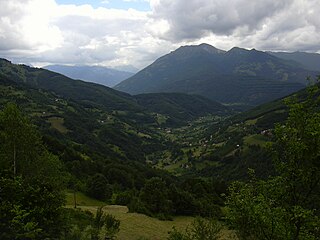
Velika is a village in the municipality of Plav, Montenegro, close to the village of Murino.

Gusinje Municipality is a municipality in eastern Montenegro in the upper Lim valley at an elevation of about 1,000 m (3,000 ft). It was created in 2014, when it split from Plav Municipality. Its center is the small town of Gusinje, and its biggest village in terms of territory is Vusanje. Two of Montenegro's highest mountains overlook Gusinje: Zla Kolata and Visitor. Many of Gusinje's settlements are historically linked with the Albanian Kelmendi tribe (fis). The village of Gusinje developed into a town the 17th century around a fortress built by the Ottomans to contain the Kelmendi. In the 19th century, Gusinje was a developing regional market center. It was engulfed in 1879–1880 in a struggle between the Principality of Montenegro that wanted to annex it and the League of Prizren that opposed it. After the Balkan Wars, Gusinje became part of Montenegro and in 1919 part of Yugoslavia. Today, it is part of Montenegro since its declaration of independence in 2006.

Jakup Ferri was an Albanian fighter from Plav-Gusinje who served as a local leader in the League of Prizren's resistance during the Principality of Montenegro's attempt to subjugate his homeland in 1879. He was distinguished in the Battle of Novšiće, where he died.
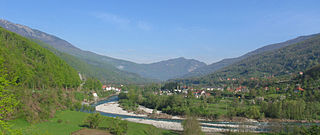
The Battle of Murino took place on January 8, 1880, between the Principality of Montenegro and the League of Prizren. It was part of the battles about the sovereignty over Plav and Gusinje. According to the treaty of Berlin, the Ottoman Empire was to hand over the region to Montenegro, but this move was militarily opposed by local Albanians. At the time of the battle, Montenegrin sources claim that around 10,000 Albanians from the League of Prizren fought against Montenegrin forces numbering 3,000, led by commanders Marko Miljanov and Todor Miljanov and priest Đoko, in Murino. Albanian sources claim that around 4,000 Albanian soldiers of the League of Prizren and 3,000 local volunteers fought against 9,000 Montenegrins.
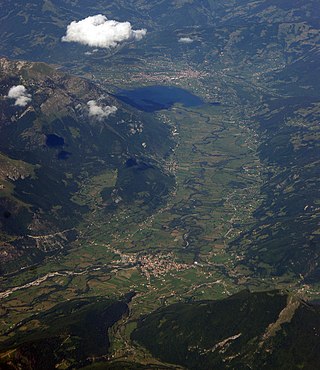
The Battles for Plav and Gusinje were armed conflicts between the Principality of Montenegro and the League of Prizren that broke out following the decision of the Congress of Berlin (1878) that the territories of Plav and Gusinje be ceded to Montenegro. The conflicts took place in this territory between 9 October 1879 and 8 January 1880. The following battles were fought:
Battle of Ulcinj was a battle between the Ottoman forces of Dervish Pasha and Albanian irregulars in the year of 1880 at the region of Kodra e Kuqe, close to Kllezna. The area of Plav and Gusinje had been handed over to Montenegro by the Treaty of Berlin (1878), but the Albanians fought against the annexation. The Great Powers then pressured the Ottomans to hand over the area of Ulcinj, but also here the Albanians refused. Eventually the Great Powers forced the Ottomans to take actions against the League of Prizren, ending the resistance and successfully handing over the town of Ulcinj to Montenegro.














